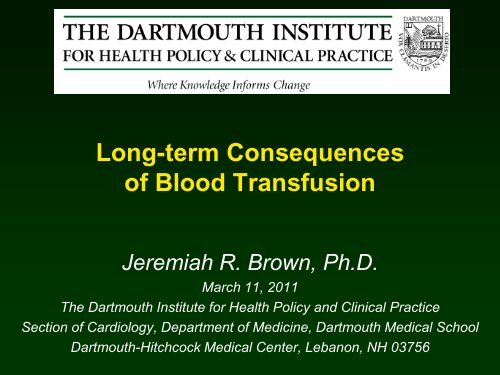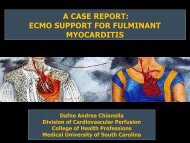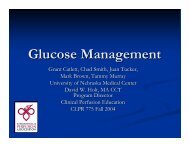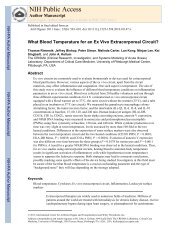PowerPoint Presentation (PDF) - Perfusion.com
PowerPoint Presentation (PDF) - Perfusion.com
PowerPoint Presentation (PDF) - Perfusion.com
Create successful ePaper yourself
Turn your PDF publications into a flip-book with our unique Google optimized e-Paper software.
Long-term Consequences<br />
of Blood Transfusion<br />
Jeremiah R. Brown, Ph.D.<br />
March 11, 2011<br />
The Dartmouth Institute for Health Policy and Clinical Practice<br />
Section of Cardiology, Department of Medicine, Dartmouth Medical School<br />
Dartmouth-Hitchcock Medical Center, Lebanon, NH 03756
No financial interests to disclose for<br />
Jeremiah R. Brown, Ph.D.
Objectives<br />
• The “Blood is bad” hypothesis<br />
• Recent evidence on transfusion<br />
• Transfusions and long-term survival
Transfusion and Cardiac Surgery<br />
• Cardiac surgery accounts for 1/3 of all<br />
blood use.<br />
• Over half of transfused blood amounts<br />
to 1-2 units, which could be foregone.<br />
• Successful out<strong>com</strong>es for bloodless<br />
surgery centers.
Stored RBCs: Purpose<br />
• RBC purpose:<br />
to increase oxygen carrying capacity.<br />
• No literature exists to support this use in<br />
the very acute surgical patient.<br />
• Stored blood has little efficacy literature.<br />
Speiss BD, SCVA 2004 8(4):267-81
Stored RBCs: Reality<br />
• Do not function normally<br />
• Contain activated inflammatory cells and<br />
mediators<br />
• These changes cause<br />
– limited oxygen release (binds oxygen but does not<br />
release it)<br />
– Impaired microcirculatory flow<br />
– Immune suppression<br />
– Aged RBCs stick together and form microaggregates<br />
Speiss BD, SCVA 2004 8(4):267-81
Quality of Stored RBCs<br />
After storage<br />
the biconcave<br />
disc gives way<br />
to a spherical<br />
shape with<br />
specula leading<br />
to inflexibility,<br />
poor microcirculation<br />
flow,<br />
and capillary<br />
damage.<br />
Holme. Trans Apheres 2005 33:55-61
Ranucci, et al. Crit Care. 2009;13(6):R207
New vs. Old Blood<br />
Crude and adjusted likelihood of experiencing major morbidity in the<br />
group receiving blood prime.<br />
Ranucci, et al. Crit Care. 2009;13(6):R207
New Evidence in 2010<br />
Hajjar, L. A. et al. JAMA<br />
2010;304:1559-1567
TRACS
Hajjar, L. A. et al. JAMA 2010;304:1559-1567<br />
Figure 1. Study Flow
Table. Baseline<br />
Characteristics of<br />
Study Patients.<br />
Hajjar, L. A. et al. JAMA 2010;304:1559-1567
Figure 2. Mean Hemoglobin Levels During the Study According to Transfusion Strategy<br />
Hajjar, L. A. et al. JAMA 2010;304:1559-1567
Figure 3. Kaplan-Meier Estimates of 30-Day Survival by Transfusion Strategy<br />
Hajjar, L. A. et al. JAMA 2010;304:1559-1567
Figure 4. Kaplan-Meier Estimates of 30-Day Survival Based on Number of Red Blood Cell<br />
(RBC) Units Transfused<br />
Hajjar, L. A. et al. JAMA 2010;304:1559-1567
Long-term Survival and<br />
Transfusion
The Risks of RBC Transfusion<br />
Transfusion and Long Term Survival<br />
Observation of 1,915 CABG pts.<br />
34% were transfused, increased risk of death for 5 years.<br />
Engoren et al., Ann Thorac Surg. 2002; 74: 1180
Long-term Survival after pRBC<br />
0 Units<br />
1<br />
2<br />
3-5<br />
6+<br />
Koch CG, et al. ATS 2006 81:1650-7
Duration of RBC Storage and Postop Complications<br />
Permission granted PS-2009-1454 Koch CG, et al., NEJM 2008 358(12):1229-39
Renal Failure<br />
New = 1.6%<br />
Old = 2.7%<br />
Newer Blood<br />
p=0.003<br />
Older Blood<br />
Permission granted PS-2009-1454 Koch CG. NEJM 2008 358(12):1229-39
The NNE Experience:<br />
Transfusion
www.nnecdsg.org<br />
Fletcher Allen<br />
Health Care<br />
Dartmouth-<br />
Hitchcock<br />
Medical<br />
Center<br />
Catholic<br />
Medical Center<br />
Eastern Maine<br />
Medical Center<br />
Central Maine<br />
Medical Center<br />
Maine Medical Center<br />
Concord Hospital<br />
Portsmouth Regional Hospital<br />
Affiliates York Hospital and<br />
Wentworth Douglass Hospital<br />
Northern New England<br />
Cardiovascular Disease<br />
Study Group<br />
The Northern New England<br />
Cardiovascular Disease Study<br />
Group exists to develop and<br />
exchange information<br />
concerning the treatment of<br />
cardiovascular disease. It is a<br />
regional, voluntary, multidisciplinary<br />
group of<br />
clinicians, hospital<br />
administrators, and health<br />
care research personnel who<br />
seek to improve continuously<br />
the quality, safety,<br />
effectiveness, and cost of<br />
medical interventions in<br />
cardiovascular disease.
Percent of total RBCs given<br />
Timing of RBCs Transfusions<br />
When are transfused RBCs given (elective & urgent patients)?<br />
(last 150 cases for each center)<br />
100<br />
80<br />
60<br />
40<br />
20<br />
0<br />
Center<br />
Preop Intraop Postop
Red Blood Cell Transfusions*<br />
≥3 units<br />
n= 728<br />
22%<br />
2 units<br />
n= 493<br />
15%<br />
11%<br />
52%<br />
None<br />
n= 1,691<br />
1 unit<br />
n= 370<br />
* Excludes: emergency, and<br />
return to OR for bleeding<br />
Surgenor et al., Circulation. 2006; 114:I43-8
Results - overall<br />
1.00<br />
5 year survival by RBC use<br />
All cardiac procedures 2001-04<br />
0.95<br />
0.90<br />
0.85<br />
log rank p value < 0.001<br />
0.80<br />
0 1 2 3 4 5<br />
Survival in years<br />
None<br />
1-2 units<br />
There is an early drop in survival with use of 1-2 units RBCs as well<br />
as a continuing decline to at least 5 years
Adjusted survival curve<br />
Adj HR = 1.16<br />
CI95% 1.01-1.34, p=0.038<br />
Use of 1-2 units of RBCs is associated with a significant 16%<br />
increased risk of death over 5 years
Adjusted HRs<br />
Adj. HR 95% CI p value<br />
Adjusted for preop<br />
variables*<br />
1.16 1.01 - 1.33 0.035<br />
Adjusted for preop and<br />
intraop variables**<br />
1.16 1.01 - 1.34 0.038<br />
* Adjusted for age, diabetes, peripheral vascular disease, CHF, COPD,<br />
preop dialysis, preop creatinine, preop WBC, preop hematocrit, ejection fraction,<br />
preop length of stay, preop IABP, priority at surgery<br />
** Adjusted for sex, age, peripheral vascular disease, diabetes, CHF, COPD,<br />
preop dialysis, preop creatinine, preop WBC, preop hematocrit, ejection fraction,<br />
number of diseased coronary arteries, preop length of stay, use of CPB,<br />
use of aprotinin, intra- or postop IABP, use of an IMA, lowest core temperature<br />
on CPB<br />
Use of 1-2 units of RBCs is associated with a significant 16%<br />
increased risk of death
Proportion surviving<br />
Proportion surviving<br />
Adjusted Survival by Red Blood Cell Use<br />
Early Phase<br />
(from surgery to 6 months)<br />
Late Phase<br />
(6 months to 5 years)<br />
1<br />
1<br />
0 . 9 9 5<br />
0 . 9 8<br />
0 . 9 9<br />
0 . 9 6<br />
0 . 9 8 5<br />
0 . 9 4<br />
0 . 9 8<br />
0 . 9 7 5<br />
Adjusted HR = 1.67<br />
95% CI = 1.21-2.28, p = 0.002<br />
0 . 9 2<br />
0 . 9<br />
Adjusted HR = 1.06<br />
95% CI = 0.91-1.24, p = 0.431<br />
0 . 9 7<br />
0 1 2 3 4 5 6<br />
M o n t h s<br />
0 . 8 8<br />
0 1 2 3 4 5<br />
Y e a r s<br />
N O RBCs RBCs N O RBCs RBCs
Adjusted Hazard Ratios
NNE Experience Summary<br />
• Exposure to 1 or 2 units of transfused<br />
RBCs is associated with a decreased<br />
long-term survival.
Transfusion Summary<br />
• Transfusion may do more harm than good.<br />
• Transfusion during the cardiac surgery<br />
admission is associated worse survival.
Thank You<br />
Jeremiah R. Brown, Ph.D.<br />
Dartmouth-Hitchcock Medical Center<br />
Lebanon, NH 03756<br />
jbrown@dartmouth.edu

















